Resident Crews of the Mir
![]()
Mir: Expedition 22 |
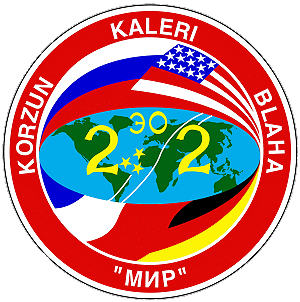 |
 |
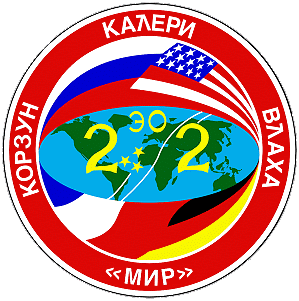 |
 |
|

|
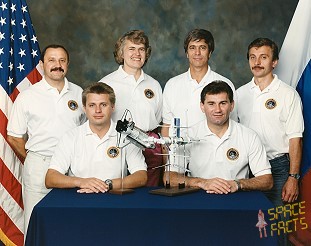 |
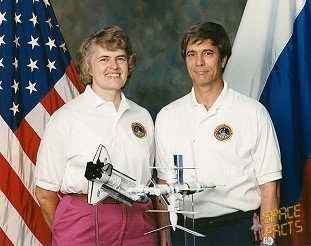 |
|
![]()
Crew, launch- and landing data
| No. | Nation | Surname | Given names | Position | Spacecraft (launch) |
Launch date |
Launch time |
Spacecraft (landing) |
Landing date |
Landing time |
Mission duration |
Orbits |
| 1 | Korzun | Valeri Grigoriyevich | Commander | Soyuz TM-24 | 17.08.1996 | 13:18:03.053 UTC | Soyuz TM-24 | 02.03.1997 | 06:44:16 UTC | 196d 17h 26m 13s | 3113 | |
| 2 | Kaleri | Aleksandr Yuriyevich | Flight Engineer | Soyuz TM-24 | 17.08.1996 | 13:18:03.053 UTC | Soyuz TM-24 | 02.03.1997 | 06:44:16 UTC | 196d 17h 26m 13s | 3113 | |
| 3 | Lucid | Shannon Matilda Wells | Research Cosmonaut | STS-76 | 22.03.1996 | 08:13:03.999 UTC | STS-79 | 26.09.1996 | 12:13:12.993 UTC | 188d 04h 00m 09s | 2977 | |
| 4 | Blaha | John Elmer | Research Cosmonaut | STS-79 | 16.09.1996 | 08:54:48.991 UTC | STS-81 | 22.01.1997 | 14:22:43.623 UTC | 128d 05h 27m 55s | 2027 | |
| 5 | Linenger | Jerry Michael | Research Cosmonaut | STS-81 | 12.01.1997 | 09:27:22.984 UTC | STS-84 | 24.05.1997 | 13:27:42.839 UTC | 132d 04h 00m 20s | 2091 |
Backup Crew
| No. | Nation | Surname | Given names | Position |
| 1 | Commander | |||
| 2 | Flight Engineer | |||
| 3 | Blaha | John Elmer | Research Cosmonaut | |
| 4 | Linenger | Jerry Michael | Research Cosmonaut | |
| 5 | Foale | Colin Michael | Research Cosmonaut |
Expedition Report
|
Launch from the Baikonur Cosmodrome and
landing 128 km east of Dzheskasgan The original prime crew (Gennadi Manakov and Pavel Vinogradov) was exchanged five days before launch due of medical problems of Gennadi Manakov. The Mir-22 mission began when the crew launched on August 17, 1996, in Soyuz TM-24 and docked with the Mir two days later. Shannon Lucid was on board Mir since she arrived with STS-76 on March 24, 1996. John Blaha joined the Mir-22 crew with the September 19, 1996, docking of STS-79. The return of STS-81 concluded a mission of experiments in the fields of advanced technology, Earth sciences, fundamental biology, human life sciences, microgravity, and space sciences, as well as send up new research experiments in these areas. Data gained from the mission supplied insight for the planning and development of the International Space Station, Earth-based sciences of human and biological processes, and the advancement of commercial technology. Earth sciences research in ocean biochemistry, land surface hydrology, meteorology, and atmospheric physics and chemistry also were performed. Observation and documentation of transient natural and human-induced changes were accomplished with the use of passive microwave radiometers, a visible region spectrometer, a side-looking radar, and hand-held photography. Earth orbit allowed for documentation of atmospheric conditions, ecological and unpredictable events, and seasonal changes over long time periods. Fundamental biology research continued developmental investigations that study the effects of the space environment on the biological systems of plants. Prolonged exposure to microgravity provides an ideal opportunity to determine the role gravity has on cell regulation and how this affects development and growth. Investigations under this discipline will also characterize the internal radiation environment of the Mir space station. Human life sciences research consisted of investigations that focus on the crewmember's adaptation to weightlessness in terms of skeletal muscle and bone changes, psychological interactions, immune system function, and metabolism. In addition, environmental factors such as water quality, air quality, surface assessment for microbes, and crew microbiology were assessed. These ambitious investigations continued the characterization of the integrated human responses to a prolonged presence in space. Space science research continued with the externally mounted Mir Sample Return Experiment (MSRE) and Particle Impact Experiment (PIE) payloads. These experiments continued to collect interstellar and interplanetary space particles to further our understanding of the origin and evolution of planetary systems and life on Earth. The French mission CASSIOPÈE carried out physiological and neurological experiments. Some of these experiments were recorded for school lessons. The scientific experiments of the crew were performed in biology, medicine, Earth observation and space technology. Protein Crystal Growth experiments in several apparatus were also part of the research work. Soyuz TM-23 undocked on September 02, 1996 at 04:20 UTC, and made a small separation burn at 04:24:40 UTC. The deorbit burn was at 06:47:20 UTC. The three modules separated at 07:14:36 UTC and the parachute deployed at 07:26 UTC. The landing was at 07:41:40 UTC, 107 km SW of Akmola in Kazakhstan with Yuri Onufriyenko, Yuri Usachyov and Claudie André-Deshays aboard. On September 03, 1996 Progress M-32 concluded its autonomous flight. This flight began on August 18, 1996, so one day before the docking of Soyuz TM-24. Approach and docking took place one orbit later than originally planned and was executed in the automatic mode with the system Kurs. The docking at the aft docking port (Kvant, +X-axis) was accomplished on September 03, 1996 at 09:35:21 UTC. Commander Valeri Korzun observed the approach via the displays of the systems LIV and TORU and reported distances, approach speeds and maneuvers around the X-axis. When both objects disappeared behind the horizon the distance was 95 meters and the speed 0.8 m/sec. Valeri Korzun had corrected the attitude of the complex. He got orders not to carry out the airseal checks and the opening of the hatch today. On September 12, 1996 the crew had spent a lot of time and efforts to repair an airseal problem in one of the modules. Obviously, the problem has been solved, but the cause of that what might have been a leakage seems to be a mystery. Meanwhile the crew started preparations for the meeting with the Atlantis (STS-79). Apart from extra physical training Shannon Lucid was packing things which she had to transfer to Atlantis for delivery on earth. Assisted by Aleksandr Kaleri, who also gave her instructions, Shannon Lucid tried out a spacesuit. She reported (in Russian) to TsUP that the suit was the right size and that she was sure to be able to use it if this might be unlooked - for necessary. TsUP confirmed that this exercise had to be done in case of an eventual return of Shannon Lucid with a Soyuz-TM. One of the means to inject oxygen in the atmosphere of the complex is the system Elektron. These systems produce oxygen out of water by an electrolysis process. Nitrogen is needed for the purging of these Elektrons, but also for the pressurizing. Nowadays there is not enough nitrogen on board and new supplies, which have to be delivered by Atlantis and Progress M-33 are badly needed. The first visiting crew arrived on September 19, 1996 with STS-79. A rendezvous and docking with the Russian Mir space station and the exchange of astronauts - including the holder of the record for longest space flight ever by a U.S. astronaut - highlighted the flight of Space Shuttle Atlantis on Mission STS-79. This was the fourth of nine planned missions to Mir between 1995 and 1998 and the first exchange of astronauts. Astronaut Shannon Lucid, who was on Mir since late March 1996, was replaced on Mir by astronaut John Blaha. He spent more than four months on Mir. He returned to Earth on Space Shuttle Mission STS-81, launched in January 1997. STS-79 was the second Shuttle-Mir mission to carry a SPACEHAB module on board, and the first to carry a double module. The forward portion of the double module housed experiments conducted by the crew before, during and after Atlantis was docked to the Russian space station. The aft portion of the double module primarily housed the logistics equipment to be transferred to the Russian space station. Logistics include food, clothing, experiment supplies, and spare equipment for Mir. STS-79 was the first shuttle mission to a fully completed Mir space station, following the arrival of its Priroda module. Atlantis carried the 1,821-kilogram (4,010 lb) Orbiter Docking System. The Shuttle-Mir link-up occurred at 15:13 UTC on September 18, 1996. The hatches opened at 05:40 UTC on September 19, 1996 and John Blaha and Shannon Lucid exchanged places at 11:00 UTC. Awaiting John Blaha on Mir were Valeri Korzun, Mir-22 Commander, and Aleksandr Kaleri, Flight Engineer. Shannon Lucid returned to Earth with STS-79 and John Blaha remained on Mir together with the 22nd Mir resident crew until STS-81 docked for the next time with the Russian space station. During her approximately six-month stay on Mir, Shannon Lucid conducted research in the following fields: advanced technology, Earth sciences, fundamental biology, human life sciences, microgravity research and space sciences. Specific experiments included: Environmental Radiation Measurements to ascertain ionizing radiation levels aboard Mir; Greenhouse-Integrated Plant Experiments, to study effect of microgravity on plants, specifically dwarf wheat; and Assessment of Humoral Immune Function During Long-Duration Space Flight, to gather data on effect of long-term spaceflight on the human immune system and involving collection of blood serum and saliva samples. Some of this research was conducted in the newest and final Mir module, Priroda, which arrived at station during Shannon Lucid's stay STS-79 marked the first flight with a double SPACEHAB module, increasing the amount of logistics the shuttle can carry to the Mir space station. In addition to the U.S. astronaut exchange, the STS-79 crew transferred over 4,600 pounds (2,087 kg) of food, water, clothing, personal hygiene supplies, replacement Mir hardware components, and U.S. science experiments and supplies to the Mir, including five powered experiments (experiments requiring electrical power on the shuttle and immediately on Mir). The Atlantis crew simultaneously received over 2,100 pounds (953 kg) of Russian hardware, empty food and water containers, ESA return science items, and U.S. science hardware, data and specimens from Shannon Lucid's science gathering activities during her stay on Mir. This was the largest shuttle transfer of logistics to and from the Mir to date. Environmental Radiation Measurements: Exposure of crew, equipment, and experiments to the ambient space radiation environment in low Earth orbit poses one of the most significant problems to long term space habitation. As part of the collaborative NASA/Mir Science program, a series of measurements were compiled of the ionizing radiation levels aboard Mir. During the mission, radiation was measured in six separate locations throughout the Mir using a variety of passive radiation detectors. This experiment continued on later missions, where measurements will be used to map the ionizing radiation environment of Mir. These measurements will yield detailed information on spacecraft shielding in the 51.6-degree-orbit of the Mir. Comparisons were made with predictions from space environment and radiation transport models. Greenhouse-Integrated Plant Experiments: The microgravity environment of the Mir space station provided researchers an outstanding opportunity to study the effects of gravity on plants, specifically dwarf wheat. The greenhouse experiment determined the effects of space flight on plant growth, reproduction, metabolism, and production. By studying the chemical, biochemical, and structural changes in plant tissues, researchers hoped to understand how processes such as photosynthesis, respiration, transpiration, stomatal conductance, and water use are affected by the space station environment. This study was an important area of research, due to the fact that plants could eventually be a major contributor to life support systems for space flight. Plants produce oxygen and food, while eliminating carbon dioxide and excess humidity from the environment. These functions are vital for sustaining life in a closed environment such as the Mir or the International Space Station. Human Life Sciences: The task of safely keeping men and women in space for long durations, whether they are doing research in Earth orbit or exploring other planets in our solar system, requires continued improvement in our understanding of the effects of space flight factors on the ways humans live and work. The Human Life Sciences (HLS) project had a set of investigations for the Mir-22 mission to determine how the body adapts to weightlessness and other space flight factors, including the psychological and microbiological aspects of a confined environment and how they readapt to Earth's gravitational forces. The results of these investigations will guide the development of ways to minimize any negative effects so that crewmembers can remain healthy and efficient during long flights, as well as after their return to Earth. Assessment of Humoral Immune Function During Long Duration Space Flight: Experiments concerned with the effects of space flight on the human immune system are important to protect the health of long duration crews. The human immune system involves both humoral (blood-borne) and cell-mediated responses to foreign substances known as antigens. Humoral responses include the production of antibodies, which can be measured in samples of saliva and serum (blood component). The cell-mediated response, which involves specialized white blood cells, appears to be suppressed during long duration space missions. Preflight, a baseline saliva and blood sample were collected. While on Mir, the crew was administered a subcutaneous antigen injection. In flight and postflight, follow-up blood and saliva samples were collected to measure the white blood cell activation response to the antigen. Two commercial payloads were transferred to Mir on STS-79 and were retrieved by STS-81 some four months later: Biotechnology System (BTS): The Bioreactor rotating wall vessel developed at the Space Cell Biology and Biotechnology Center at NASA's Johnson Space Center was the first of a series of long-duration cell culture experiments. BTS studied the three-dimensional growth of cartilage cells during its 147-day mission. Material in Devices as Superconductors (MIDAS): The MIDAS experiment developed at NASA's Langley Research Center, Hampton, VA, flew into orbit on STS-79 and was transferred over to the Russian Mir space station for approximately four months. While on the Mir, MIDAS measured the electrical properties of high temperature superconductor (HTS) materials during extended space flight and compiled the results in a database for commercial use. HTS materials may be used in a variety of device applications to reduce power requirements and thermal losses. In addition to the development of a database, the MIDAS experiment demonstrated the development of a manufacturing process using integrated superconductor and conventional microelectronics. There have been no previous flights which characterize HTS material in spaceflight at cryogenic temperatures. Commercial Generic Bioprocessing Apparatus (CGBA): The CGBA hardware was used extensively on short duration Shuttle missions to house a great variety of biotechnology experiments of interest to commercial product development. There are many biotechnology processes which require much longer periods of time than a Shuttle mission can provide. For this reason, the commercial affiliates of BioServe Space Technologies, a NASA Commercial Space Center, are eager to take advantage of the long duration mission which the Shuttle/Mir program provides. STS-79 undocked from Mir on September, 1996. Atlantis backed away from Mir to a distance of about 600 feet, where Commander William Readdy and Pilot Terrence Wilcutt began a flyaround of the station. Atlantis circled Mir twice before firing its jets again to depart. During this flyaround the crew performed documentary photography of the Mir space station, including the newly arrived Priroda science module, using still and video cameras as well as the IMAX large format movie camera. Progress M-33 brought food, water, fuel, post, spare parts, etc. to the station. The crew was anxiously waiting for containers for the collection of 'human waste'. The available containers were as good as full and the crew had to 'improvise' measures to keep this situation under control. They did not complain about this problem, but have no appreciation for the fact that TV-stations in Russia made it public as this caused anxiety among their relatives. There also has been a publication about the fact that their vacuum cleaner was out of order. Progress M-33 was launched on November 13, 1996 at 23:30 UTC, docked with Mir on November 22, 1996 at 01:01:30 UTC and undocked on February 06, 1997 at 12:13:53 UTC. Thereafter in independent orbital flight in a 377 x 395 km x 51.65 deg orbit followed. It failed to redock with Mir on March 04, 1996 and was destroyed in reentry on March 12, 1997 at 03:23:37 UTC. The cargo of Progress M-33 consisting of post, food, spare-parts, and containers for human waste and materials for experiments weighs 1650 kg. In the tank-compartment of Progress M-33 547 kg oxygen, fuel and water was stored. Fuel for the Mir complex itself weighed 2462 kg. Also, among the 547 kg a new supply of nitrogen for the pressurizing and purging of the oxygen-producing Elektron systems was onboard. Because of the fact that there will be no further deliveries of supplies before New Year the mail-bag also contains the Christmas- and New Year post for the crew. The first EVA by Valeri Korzun and Aleksandr Kaleri occurred on December 02, 1996 (5h 57m). They had to deploy and connect cables to the American solar panel on the outer surface of Kvant1. They accomplished their task successfully and without problems. The solar panel has been checked and could deliver a current of 80 Amperes. Valeri Korzun reported the closure of the hatch at 21:57 UTC. Regularly John Blaha was in contacts with TsUP and the cosmonauts. Inside the Mir complex he assisted the cosmonauts, checked systems and executed commands given to him by TsUP. While Valeri Korzun and Aleksandr Kaleri were still in the airlock to equalize the air pressure John Blaha in co-ordination with TsUP loaded control-data in the central computer. Valeri Korzun and Aleksandr Kaleri performed the second spacewalk on December 09, 1996 (6h 36m). The EVA lasted longer for Valeri Korzun wished to accomplish all what had to be done and there also was a problem with something which bungled loose. Before return they restored the connection of the radio-amateur antenna for the 145 mc. Probably this antenna had been disconnected by accident during the 1st EVA. They connected the antenna again and while they were flying over Chile and Brazil, they asked John Blaha to listen out on the 145.800 mc to check whether the antenna was working or not. There was no traffic on that frequency in that area and so they had to wait until they came in range of European amateurs. The cosmonauts fully accomplished their tasks: installing the truss construction Rapana at the truss Ferma-3 and the replacement of the Kurs-antenna on the outer surface of the transition section. John Blaha who stayed inside the complex took care of the communications and executed commands given to him by TsUP. He gave the cosmonauts all possible moral and technical help. The cosmonauts and John Blaha did an excellent job during this EVA, they gave an example of fruitful international co-operation and so they all deserve a loud: 'MOLODTSY' (very well done). Of course, the cosmonauts were very tired after the EVA and back in the airlock they had to do hard labour to put off their spacesuits. As of January 01, 1997, the Mir complex remained in a so called solar-orbit for one week. This means that the Mir remained in the sunlight and had no shadow periods. While large areas on the Northern Hemisphere experience very low temperatures these are high on-board the space station. The cosmonauts and the astronaut had to wear airy clothing. On January 15, 1997 the next Space Shuttle STS-81 docked with the Russian space station Mir. This was the fifth of nine planned missions to Mir and the second one involving an exchange of U.S. astronauts. Astronaut John Blaha, who was on Mir since September 19, 1996, was replaced by astronaut Jerry Linenger. He spent more than four months on Mir and returned to Earth on Space Shuttle Mission STS-84, launched in May 1997. Atlantis again carried the SPACEHAB module in the payload bay of the orbiter. The double module configuration housed experiments to be performed by Atlantis' crew along with logistics equipment to be transferred to Mir. Docking occurred at 03:54 UTC, January 15, 1997, followed by hatch opening. Jerry Linenger officially traded places at 09:45 UTC with John Blaha who spent 118 days on the station and 128 days total on-orbit. Jerry Linenger was Mission Specialist-4 for launch through docking with Mir. Shortly after docking, Jerry Linenger and John Blaha conducted their handover with Jerry Linenger becoming a member of the Mir-22 crew and John Blaha becoming Mission Specialist-4 through the end of the flight. Atlantis carried the SPACEHAB double module providing additional middeck locker space for secondary experiments. During the five days of docked operations with Mir, the crews transferred water and supplies from one spacecraft to the other. A spacewalk by Jerry Linenger and one by his Russian cosmonaut crewmates occurred after the departure of Atlantis. STS-81 was involved in the transfer of 2,710 kilograms (6,000 lb) of logistics to and from the Mir, the largest transfer of items to date. During the docked phase, 635 kilograms (1,400 lb) of water, 516.1 kilograms (1,138 lb) of U.S. science equipment, 1,000.7 kilograms (2,206 lb) of Russian logistics along with 121.7 kilograms (268 lb) of miscellaneous material was transferred to Mir. Returned to Earth aboard Atlantis was 570.0 kilograms (1,257 lb) of U.S. science material, 404.5 kilograms (892 lb) of Russian logistics and 97.3 kilograms (215 lb) of miscellaneous material. Environmental Radiation Measurements: Exposure of crew, equipment, and experiments to the ambient space radiation environment in low Earth orbit poses one of the most significant problems to long term space habitation. As part of the collaborative NASA/Mir Science program, a series of measurements were compiled of the ionizing radiation levels aboard Mir. During the mission, radiation was measured in six separate locations throughout the Mir using a variety of passive radiation detectors. This experiment continued on later missions, where measurements will be used to map the ionizing radiation environment of Mir. These measurements will yield detailed information on spacecraft shielding in the 51.6-degree-orbit of the Mir. Comparisons were made with predictions from space environment and radiation transport models. Greenhouse-Integrated Plant Experiments: The microgravity environment of the Mir space station provided researchers an outstanding opportunity to study the effects of gravity on plants, specifically dwarf wheat. The greenhouse experiment determined the effects of space flight on plant growth, reproduction, metabolism, and production. By studying the chemical, biochemical, and structural changes in plant tissues, researchers hoped to understand how processes such as photosynthesis, respiration, transpiration, stomatal conductance, and water use are affected by the space station environment. This study was an important area of research, due to the fact that plants could eventually be a major contributor to life support systems for space flight. Plants produce oxygen and food, while eliminating carbon dioxide and excess humidity from the environment. These functions are vital for sustaining life in a closed environment such as the Mir or the International Space Station. Human Life Sciences: The task of safely keeping men and women in space for long durations, whether they are doing research in Earth orbit or exploring other planets in our solar system, requires continued improvement in our understanding of the effects of space flight factors on the ways humans live and work. The Human Life Sciences (HLS) project had a set of investigations planned for the Mir-23NASA 4 mission to determine how the body adapts to weightlessness and other space flight factors, including the psychological and microbiological aspects of a confined environment and how they readapt to Earth's gravitational forces. The results of these investigations will guide the development of ways to minimize any negative effects so that crewmembers can remain healthy and efficient during long flights, as well as after their return to Earth. Assessment of Humoral Immune Function During Long Duration Space Flight: Experiments concerned with the effects of space flight on the human immune system are important to protect the health of long duration crews. The human immune system involves both humoral (blood-borne) and cell-mediated responses to foreign substances known as antigens. Humoral responses include the production of antibodies, which can be measured in samples of saliva and serum (blood component). The cell-mediated response, which involves specialized white blood cells, appears to be suppressed during long duration space missions. Preflight, baseline saliva and blood sample were collected. While on Mir, the crew was administered a subcutaneous antigen injection. In flight and postflight, follow-up blood and saliva samples were collected to measure the white blood cell activation response to the antigen. Diffusion-Controlled Crystallization Apparatus for Microgravity: Protein crystals are used in basic biological research, pharmacology and drug development. Earth's gravity affects the purity and structural integrity of crystals. The low gravity environment in space allows for the growth of larger, purer crystals of greater structural integrity. Therefore, the analyses of some protein crystals grown in space have revealed more about a protein's molecular structure than crystals grown on Earth. During STS-81, astronauts retrieved protein samples that have been growing on Mir since the STS-79 docking on September 19, 1996 and replaced them with new samples. In the experiment chamber called the Diffusion-controlled Crystallization Apparatus for Microgravity (DCAM), crew members removed the "growing" samples and replaced them with 162 new samples. The DCAM was designed to grow protein crystals in a microgravity environment. It used the liquid/liquid and dialysis methods in which a precipitant solution diffused into a bulk solution. In the DCAM, a "button" covered by a semi-permeable membrane held a small protein sample but allowed the precipitant solution to pass into the protein solution to initiate the crystallization process. The DCAM was a method to passively control the crystallization process over extended periods of time. Gaseous Nitrogen Dewar: Frozen protein samples were transported to the Russian Mir space station in a gaseous nitrogen Dewar (GN2 Dewar) on STS-81, and the existing protein crystals on board Mir from the STS-79 mission were returned to Earth for laboratory analysis. The Dewar was a vacuum jacketed container with an absorbent inner liner saturated with liquid nitrogen. The protein samples remained frozen for approximately two weeks, until the liquid nitrogen had completely boiled off. This provided ample time to transport and transfer the Dewar to the Mir station. After the liquid nitrogen is completely discharged, the samples will thaw to ambient temperature and protein crystals will nucleate and start growing over the four-month duration of the mission. Liquid Metal Diffusion (LMD) using MIM: The LMD experiment measured the diffusion rate of molten indium at approximately 392 F. Diffusion is the process by which individual atoms or molecules move as a result of random collisions with neighboring atoms and molecules. Diffusion is difficult to study on Earth because gravity masks the effect of the collisions, that is, hot pockets of liquid rise while the more dense, cooler areas sink. Radiation detectors in the LMD hardware measured the diffusive motions of a radioactive tracer in non-radioactive indium. The Microgravity Isolation Mount (MIM) was used to isolate the experiment from vibrations which could disturb the liquid indium during the experiment and induce motions which are not diffusive. The MIM also was used to provide measured vibrations for some samples to determine how easily diffusion can be affected by these forces. A total of five samples were processed. The information obtained from diffusion measurements can be used to determine the rate at which material travels between two bodies of fluids separated by a stagnant layer which the material must diffuse through. This is a common occurrence for some types of crystal growth and alloy processing on Earth. Optical Properties Monitor (OPM): OPM was the first experiment capable of relaying on-orbit data which measured the effect of the space environment on optical properties, such as those of mirrors used in telescopes, and structural elements, such as the coatings used on space hardware. OPM instruments measured various optical properties of the, overall showing to what extent the samples deteriorate over the course of the experiment. Once aboard Mir, American astronauts and Russian cosmonauts mounted the monitor to the outside of the space station. This marked the first experiment deployed jointly by the U.S. and Russia, setting the stage for how the astronauts and cosmonauts will work together on the International Space Station. During its scheduled nine months on Mir, the experiment measured the environment's effect on nearly 100 sample materials. The monitor was the first externally powered experiment in space, using a power-data line to receive power from and transmit information to the Mir. The monitor collected and stored measurements to be transferred weekly to a Mir computer, then to scientists on Earth. The crew also tested on Shuttle the Treadmill Vibration Isolation and Stabilization System (TVIS), designed for use in the Russian Service Module of the International Space Station. Another activity related to International Space Station involved firing the orbiter's small vernier jet thrusters during mated operations to gather engineering data. STS-81 undocked on January 20, 1997. Atlantis backed away from Mir to a distance of about 600 feet (182.9 meters), where Pilot Brent Jett began a flyaround of the station. Atlantis circled Mir twice before firing its jets again to depart the vicinity of the station. On February 07, 1997 at 16:28:01 UTC the Mir-22 crew and American Research Cosmonaut Jerry Linenger undocked the Soyuz TM-24 ferry from the front docking port, flew it around to the far side of the complex and redocked at the rear Kvant port at 16:51:27 UTC. This cleared the forward port for the arrival of the Mir-23 crew Commander Vasili Tsibliyev and Flight Engineer Aleksandr Lazutkin, who brought with them German Research Cosmonaut Reinhold Ewald on February 12, 1997. On February 24, 1997 an oxygen cartridge caught fire and a grey smoke spread out in all parts of the complex. Valeri Korzun and Aleksandr Kaleri fought against the fire with extinguishers and the others tried to push back the smoke. All crew members had to wear gas-masks. This lasted two and a half hours the maximum endurance of those masks. The extinction water caused a high humidity and the temperature of the atmosphere was higher than normal. Reinhold Ewald did not get smoke or just a little bit in his longs and to remain on the safe side he swallowed coal- and vitamin tablets and milk products. He was very tired but he did not think that this had been caused by something like pollution, but by the lack of sleep. Jerry Linenger was very busy collecting air samples for pollution tests. He also tried to determine the amount of formaldehyde. The crew of six was in the Base Block when the fire began in an adjacent room. Russian toxicologists are analyzing telemetric data about Mir's on board atmosphere. The crew already collected urine- and saliva samples and later on they got instructions to collect blood samples and to do additional medical tests. The Soyuz spacecraft is composed of three elements attached end-to-end - the Orbital Module, the Descent Module and the Instrumentation/Propulsion Module. The crew occupied the central element, the Descent Module. The other two modules are jettisoned prior to re-entry. They burn up in the atmosphere, so only the Descent Module returned to Earth. Having shed two-thirds of its mass, the Soyuz reached Entry Interface - a point 400,000 feet (121.9 kilometers) above the Earth, where friction due to the thickening atmosphere began to heat its outer surfaces. With only 23 minutes left before it lands on the grassy plains of central Asia, attention in the module turned to slowing its rate of descent. Eight minutes later, the spacecraft was streaking through the sky at a rate of 755 feet (230 meters) per second. Before it touched down, its speed slowed to only 5 feet (1.5 meter) per second, and it lands at an even lower speed than that. Several onboard features ensure that the vehicle and crew land safely and in relative comfort. Four parachutes, deployed 15 minutes before landing, dramatically slowed the vehicle's rate of descent. Two pilot parachutes were the first to be released, and a drogue chute attached to the second one followed immediately after. The drogue, measuring 24 square meters (258 square feet) in area, slowed the rate of descent from 755 feet (230 meters) per second to 262 feet (80 meters) per second. The main parachute was the last to emerge. It is the largest chute, with a surface area of 10,764 square feet (1,000 square meters). Its harnesses shifted the vehicle's attitude to a 30-degree angle relative to the ground, dissipating heat, and then shifted it again to a straight vertical descent prior to landing. The main chute slowed the Soyuz to a descent rate of only 24 feet (7.3 meters) per second, which is still too fast for a comfortable landing. One second before touchdown, two sets of three small engines on the bottom of the vehicle fired, slowing the vehicle to soften the landing. Valeri Korzun, Aleksandr Kaleri and Reinhold Ewald undocked from Mir in the Soyuz TM-24 spaceship at 03:24 UTC on March 02, 1997 and landed at 06:44:16 UTC in Kazakhstan. |
EVA data
| Name | Start | End | Duration | Mission | Airlock | Suit | |
| EVA | Kaleri, Aleksandr | 02.12.1996, 15:54 UTC | 02.12.1996, 21:51 UTC | 5h 57m | Soyuz TM-24 | Mir - Kvant2 | Orlan-DMA No. 26 |
| EVA | Korzun, Valeri | 02.12.1996, 15:54 UTC | 02.12.1996, 21:51 UTC | 5h 57m | Soyuz TM-24 | Mir - Kvant2 | Orlan-DMA No. 27 |
| EVA | Kaleri, Aleksandr | 09.12.1996, 13:52 UTC | 09.12.1996, 20:28 UTC | 6h 36m | Soyuz TM-24 | Mir - Kvant2 | Orlan-DMA No. 26 |
| EVA | Korzun, Valeri | 09.12.1996, 13:52 UTC | 09.12.1996, 20:28 UTC | 6h 36m | Soyuz TM-24 | Mir - Kvant2 | Orlan-DMA No. 27 |
Relocations of Manned Spacecrafts
| Spacecraft | from | Undocking | Time UTC | to | Redocking | Time UTC |
| Soyuz TM-24 | Mir - Baseblock | 07.02.1997 | 16:28:01 | Mir - Kvant | 07.02.1997 | 16:51:27 |
Graphics / Photos
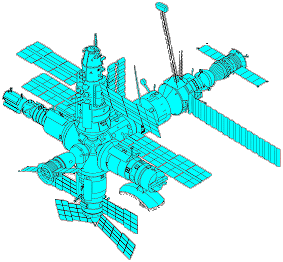 |
 |
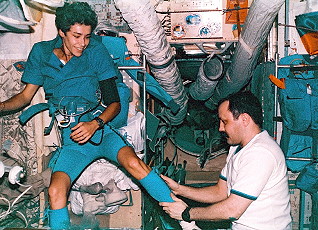 |
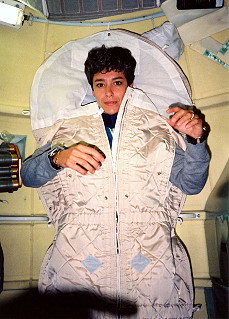 |
 |
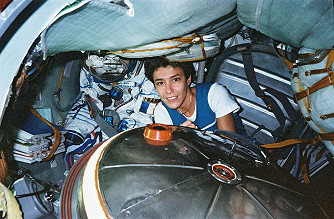 |
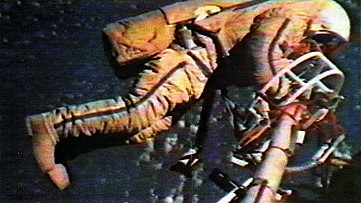 |
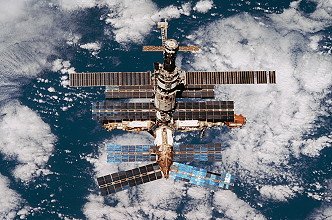 |
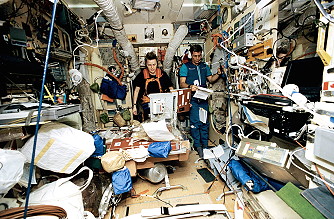 |
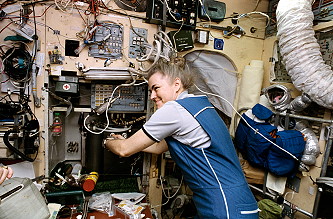 |
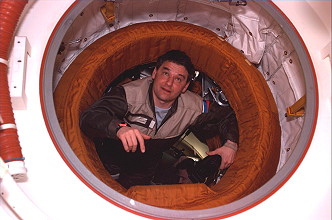 |
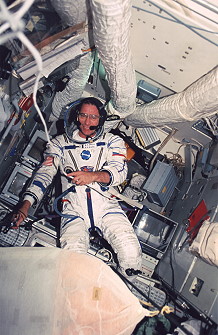 |
| © |  |
Last update on September 06, 2021.  |
 |